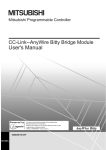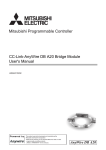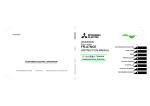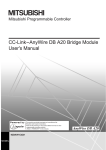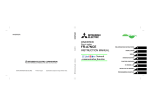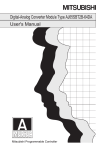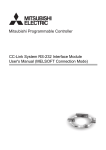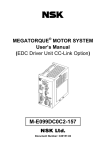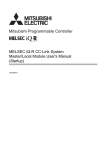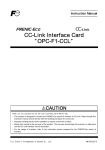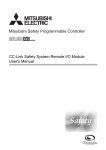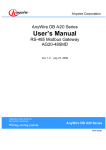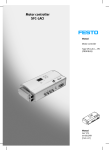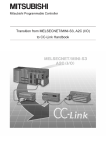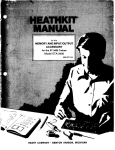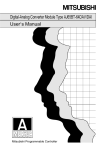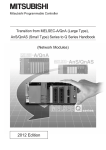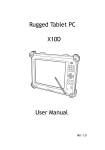Download CC-Link-AnyWire Bitty Bridge Module User`s Manual
Transcript
CC-Link-AnyWire Bitty Bridge Module
User's Manual
-NZ2AW1C1BY
This document is protected by the law of copyright, whereby all rights established therein remain with the
company Mitsubishi Electric Corporation. Reproduction of this document or parts of this document is only
permissible within the limits of the legal determination of Copyright Law. Alteration or abridgement of the
document is not permitted without the explicit written approval of the company Mitsubishi Electric
Corporation.
PRECAUTIONS REGARDING WARRANTY AND
SPECIFICATIONS
The NZ2AW1C1BY is jointly developed and manufactured by Mitsubishi and Anywire Corporation.
Note that there are some precautions regarding warranty and specifications of this product.
<Warranty>
Other programmable controller
Item
products
NZ2AW1C1BY
(e.g. MELSEC-Q series)
Repair term after discontinuation of
production
1 year
7 years
<Application of the EMC Directive>
Other programmable controller
Item
products
NZ2AW1C1BY
(e.g. MELSEC-Q series)
Applicable EMC standard
*1
EN61131-2*1
EN61131-2
The module with a serial number (the sixth digit) of 3 or later must comply with this standard.
<Application of the UL/cUL standards>
Other programmable controller
Item
NZ2AW1C1BY
products
(e.g. MELSEC-Q series)
Applicable UL standard/cUL standard
*1
UL508*1
UL508
CSA22.2*1
CSA22.2
The module with a serial number (the sixth digit) of 3 or later must comply with this standard.
1
SAFETY PRECAUTIONS
(Read these precautions before using this product.)
Before using this product, please read this manual and the relevant manuals carefully and pay full attention
to safety to handle the product correctly.
The precautions given in this manual are concerned with this product only. For the safety precautions of the
programmable controller system, refer to the user’s manual for the CPU module used.
In this manual, the safety precautions are classified into two levels: "
WARNING" and "
CAUTION".
WARNING
Indicates that incorrect handling may cause hazardous conditions,
resulting in death or severe injury.
CAUTION
Indicates that incorrect handling may cause hazardous conditions,
resulting in minor or moderate injury or property damage.
Under some circumstances, failure to observe the precautions given under "
CAUTION" may lead to
serious consequences.
Observe the precautions of both levels because they are important for personal and system safety.
Make sure that the end users read this manual and then keep the manual in a safe place for future
reference.
[Design Precautions]
WARNING
● An AnyWire Bitty system has no control function for ensuring safety.
● When a communication failure occurs in the network, data in the master module are held.
Check the communication status information and configure an interlock circuit in the sequence
program to ensure that the entire system will operate safely.
[Design Precautions]
CAUTION
● Do not install the control lines or communication cables together with the main circuit lines or power
cables. Keep a distance of 100mm or more between them. Failure to do so may result in malfunction
due to noise.
● Configure safety circuits, such as an emergency stop circuit and interlock circuit, external to the
AnyWire Bitty system.
2
[Installation Precautions]
CAUTION
● Use the module in an environment that meets the general specifications in this manual. Failure to do
so may result in electric shock, fire, malfunction, or damage to or deterioration of the product.
● Securely fix the module with a DIN rail.
● Do not directly touch any conductive parts or electronic components of the module.
Doing so can cause malfunction or failure of the module.
[Wiring Precautions]
CAUTION
● Shut off the external power supply for the system in all phases before wiring. Failure to do so may
result in electric shock or cause the module to fail or malfunction.
● Individually ground the FG terminal of the programmable controller with a ground resistance of 100
or less. Failure to do so may result in electric shock or malfunction.
● Check the rated voltage and terminal layout before wiring to the module, and connect the cables
correctly. Connecting a power supply with a different voltage rating or incorrect wiring may cause a
fire or failure.
● Tighten the terminal screw within the specified torque range.
Undertightening can cause short circuit, fire or malfunction.
Overtightening can damage the screw and/or module, resulting in drop, short circuit, or malfunction.
● Prevent foreign matter such as dust or wire chips from entering the module.
Such foreign matter can cause a fire, failure, or malfunction.
● Incorrect wiring may damage modules and external devices. Adjust a cable length and a module
position to prevent disconnection of a connector-type terminal block or a cable.
● Do not solder stranded wires of a cable when connecting them to the terminal block. Doing so may
cause poor contact.
● The power supply voltage of remote slave modules may be insufficient due to a voltage drop in the
power supply line. Connect an external power supply so that the voltage of remote slave modules is
ensured.
● Do not apply the 24VDC power before wiring the entire AnyWire Bitty system.
● Use 24VDC stabilized power supplies for devices in the AnyWire Bitty system.
● Do not install the control lines or communication cables together with the main circuit lines or power
cables.
Failure to do so may result in malfunction due to noise.
3
[Wiring Precautions]
CAUTION
● Make sure to place the communication and power cables to be connected to the module in a duct or
fasten them using a clamp. If the cables are not placed in a duct or fastened with a clamp, their
positions may be unstable or moved, and they may be pulled inadvertently.
This may damage the module and the cables or cause the module to malfunction because of faulty
cable connections.
● When disconnecting the communication and power cables from the module, do not pull the cables
by hand.
When disconnecting a cable connected to a terminal block, loosen the screws on the terminal block
first before removing the cable. If a cable is pulled while being connected to the module, it may
cause the module to malfunction or damage the module and the cable.
[Startup and Maintenance Precautions]
WARNING
● Do not touch any terminal while power is on. Doing so will cause electric shock or malfunction.
● Shut off the external power supply (all phases) used in the system before cleaning the module or
retightening the terminal screws or module fixing screws.
Failure to do so may result in electric shock.
Undertightening the terminal screws can cause short circuit or malfunction.
Overtightening can damage the screw and/or module, resulting in drop, short circuit, or malfunction.
[Startup and Maintenance Precautions]
CAUTION
● Do not disassemble or modify the modules.
Doing so may cause failure, malfunction, injury, or a fire.
● Shut off the external power supply (all phases) used in the system before mounting or removing a
module.
Failure to do so may cause the module to fail or malfunction.
● Before handling the module, touch a grounded metal object to discharge the static electricity from
the human body.
Failure to do so may cause the module to fail or malfunction.
[Disposal Precautions]
CAUTION
● When disposing of this product, treat it as industrial waste.
4
CONDITIONS OF USE FOR THE PRODUCT
(1) Mitsubishi programmable controller ("the PRODUCT") shall be used in conditions;
i) where any problem, fault or failure occurring in the PRODUCT, if any, shall not lead to any major
or serious accident; and
ii) where the backup and fail-safe function are systematically or automatically provided outside of
the PRODUCT for the case of any problem, fault or failure occurring in the PRODUCT.
(2) The PRODUCT has been designed and manufactured for the purpose of being used in general
industries.
MITSUBISHI SHALL HAVE NO RESPONSIBILITY OR LIABILITY (INCLUDING, BUT NOT
LIMITED TO ANY AND ALL RESPONSIBILITY OR LIABILITY BASED ON CONTRACT,
WARRANTY, TORT, PRODUCT LIABILITY) FOR ANY INJURY OR DEATH TO PERSONS OR
LOSS OR DAMAGE TO PROPERTY CAUSED BY the PRODUCT THAT ARE OPERATED OR
USED IN APPLICATION NOT INTENDED OR EXCLUDED BY INSTRUCTIONS, PRECAUTIONS,
OR WARNING CONTAINED IN MITSUBISHI'S USER, INSTRUCTION AND/OR SAFETY
MANUALS, TECHNICAL BULLETINS AND GUIDELINES FOR the PRODUCT.
("Prohibited Application")
Prohibited Applications include, but not limited to, the use of the PRODUCT in;
• Nuclear Power Plants and any other power plants operated by Power companies, and/or any
other cases in which the public could be affected if any problem or fault occurs in the PRODUCT.
• Railway companies or Public service purposes, and/or any other cases in which establishment of
a special quality assurance system is required by the Purchaser or End User.
• Aircraft or Aerospace, Medical applications, Train equipment, transport equipment such as
Elevator and Escalator, Incineration and Fuel devices, Vehicles, Manned transportation,
Equipment for Recreation and Amusement, and Safety devices, handling of Nuclear or
Hazardous Materials or Chemicals, Mining and Drilling, and/or other applications where there is a
significant risk of injury to the public or property.
Notwithstanding the above, restrictions Mitsubishi may in its sole discretion, authorize use of the
PRODUCT in one or more of the Prohibited Applications, provided that the usage of the PRODUCT
is limited only for the specific applications agreed to by Mitsubishi and provided further that no
special quality assurance or fail-safe, redundant or other safety features which exceed the general
specifications of the PRODUCTs are required. For details, please contact the Mitsubishi
representative in your region.
5
COMPLIANCE WITH EMC AND LOW VOLTAGE
DIRECTIVES
(1) Method of ensuring compliance
To ensure that Mitsubishi programmable controllers maintain EMC and Low Voltage Directives when incorporated
into other machinery or equipment, certain measures may be necessary. Please refer to one of the following
manuals.
• User's manual for the CPU module or head module used
• Safety Guidelines
(This manual is included with the CPU module, base unit, or head module.)
The CE mark on the side of the programmable controller indicates compliance with EMC and Low Voltage
Directives.
(2) Additional measures
To ensure that this product maintains EMC and Low Voltage Directives, please refer to Page 65, Appendix 1.
6
Memo
7
CONTENTS
CONTENTS
PRECAUTIONS REGARDING WARRANTY AND SPECIFICATIONS . . . . . . . . . . . . . . . . . . . . . . . . . . . 1
SAFETY PRECAUTIONS . . . . . . . . . . . . . . . . . . . . . . . . . . . . . . . . . . . . . . . . . . . . . . . . . . . . . . . . . . . . . 2
CONDITIONS OF USE FOR THE PRODUCT . . . . . . . . . . . . . . . . . . . . . . . . . . . . . . . . . . . . . . . . . . . . . 5
COMPLIANCE WITH EMC AND LOW VOLTAGE DIRECTIVES . . . . . . . . . . . . . . . . . . . . . . . . . . . . . . . 6
TERMS . . . . . . . . . . . . . . . . . . . . . . . . . . . . . . . . . . . . . . . . . . . . . . . . . . . . . . . . . . . . . . . . . . . . . . . . . . 10
CHAPTER 1 OVERVIEW
11
CHAPTER 2 SPECIFICATIONS
13
2.1
2.2
2.3
General Specifications . . . . . . . . . . . . . . . . . . . . . . . . . . . . . . . . . . . . . . . . . . . . . . . . . . . . . . . 13
Performance Specifications . . . . . . . . . . . . . . . . . . . . . . . . . . . . . . . . . . . . . . . . . . . . . . . . . . . 14
2.2.1
Performance specifications . . . . . . . . . . . . . . . . . . . . . . . . . . . . . . . . . . . . . . . . . . . . . . . . . . 14
2.2.2
Scope of the power supply for the transmission line . . . . . . . . . . . . . . . . . . . . . . . . . . . . . . . 16
2.2.3
Power supply sequence and handling of I/O data . . . . . . . . . . . . . . . . . . . . . . . . . . . . . . . . . 19
Applicable System . . . . . . . . . . . . . . . . . . . . . . . . . . . . . . . . . . . . . . . . . . . . . . . . . . . . . . . . . . 20
2.3.1
Applicable master module . . . . . . . . . . . . . . . . . . . . . . . . . . . . . . . . . . . . . . . . . . . . . . . . . . . 20
2.3.2
Differences in parameter settings depending on the CC-Link versions . . . . . . . . . . . . . . . . . 20
2.3.3
CC-Link dedicated instruction . . . . . . . . . . . . . . . . . . . . . . . . . . . . . . . . . . . . . . . . . . . . . . . . 21
2.4
External Dimensions . . . . . . . . . . . . . . . . . . . . . . . . . . . . . . . . . . . . . . . . . . . . . . . . . . . . . . . . 22
2.5
Part Names . . . . . . . . . . . . . . . . . . . . . . . . . . . . . . . . . . . . . . . . . . . . . . . . . . . . . . . . . . . . . . . 23
2.6
Checking Function Version and Serial Number . . . . . . . . . . . . . . . . . . . . . . . . . . . . . . . . . . . . 24
CHAPTER 3 MODULE MOUNTING
25
CHAPTER 4 CONNECTIONS
27
4.1
4.2
4.3
CC-Link Side Terminal Block . . . . . . . . . . . . . . . . . . . . . . . . . . . . . . . . . . . . . . . . . . . . . . . . . . 27
4.1.1
Connecting a CC-Link dedicated cable . . . . . . . . . . . . . . . . . . . . . . . . . . . . . . . . . . . . . . . . . 28
4.1.2
Cable processing . . . . . . . . . . . . . . . . . . . . . . . . . . . . . . . . . . . . . . . . . . . . . . . . . . . . . . . . . . 28
AnyWire Bitty Side Terminal Block . . . . . . . . . . . . . . . . . . . . . . . . . . . . . . . . . . . . . . . . . . . . . . 29
4.2.1
Description of the terminals of an AnyWire Bitty side terminal block . . . . . . . . . . . . . . . . . . . 29
4.2.2
Cable processing . . . . . . . . . . . . . . . . . . . . . . . . . . . . . . . . . . . . . . . . . . . . . . . . . . . . . . . . . . 30
Terminating Unit . . . . . . . . . . . . . . . . . . . . . . . . . . . . . . . . . . . . . . . . . . . . . . . . . . . . . . . . . . . . 31
CHAPTER 5 SWITCH SETTING
5.1
CC-Link Side . . . . . . . . . . . . . . . . . . . . . . . . . . . . . . . . . . . . . . . . . . . . . . . . . . . . . . . . . . . . . . 32
5.2
AnyWire Bitty Side . . . . . . . . . . . . . . . . . . . . . . . . . . . . . . . . . . . . . . . . . . . . . . . . . . . . . . . . . . 34
CHAPTER 6 MEMORY MAPS
8
32
35
6.1
Remote I/O Signal List . . . . . . . . . . . . . . . . . . . . . . . . . . . . . . . . . . . . . . . . . . . . . . . . . . . . . . . 35
6.2
Remote Register List . . . . . . . . . . . . . . . . . . . . . . . . . . . . . . . . . . . . . . . . . . . . . . . . . . . . . . . . 36
6.3
Correspondence between the Remote Register and AnyWire Address . . . . . . . . . . . . . . . . . 38
6.4
Error Reset . . . . . . . . . . . . . . . . . . . . . . . . . . . . . . . . . . . . . . . . . . . . . . . . . . . . . . . . . . . . . . . . 39
CHAPTER 7 PREPARATION FOR OPERATION
40
7.1
Setting by the Parameter . . . . . . . . . . . . . . . . . . . . . . . . . . . . . . . . . . . . . . . . . . . . . . . . . . . . . 40
7.2
Setting on the Program. . . . . . . . . . . . . . . . . . . . . . . . . . . . . . . . . . . . . . . . . . . . . . . . . . . . . . . 43
CHAPTER 8 POWER-ON AND PART INDICATION
8.1
LED Indication Specification . . . . . . . . . . . . . . . . . . . . . . . . . . . . . . . . . . . . . . . . . . . . . . . . . . . 46
CHAPTER 9 MONITORING FUNCTION
9.1
48
Automatic Address Detection . . . . . . . . . . . . . . . . . . . . . . . . . . . . . . . . . . . . . . . . . . . . . . . . . . 48
9.1.1
9.2
45
Automatic address detection operation . . . . . . . . . . . . . . . . . . . . . . . . . . . . . . . . . . . . . . . . . 48
Monitoring Operation . . . . . . . . . . . . . . . . . . . . . . . . . . . . . . . . . . . . . . . . . . . . . . . . . . . . . . . . 50
CHAPTER 10 CC-LINK I/O RESPONSE TIME
51
CHAPTER 11 TRANSMISSION TIME
53
11.1
11.2
Transmission Cycle Time . . . . . . . . . . . . . . . . . . . . . . . . . . . . . . . . . . . . . . . . . . . . . . . . . . . . . 53
11.1.1
Transmission cycle time of the NZ2AW1C1BY . . . . . . . . . . . . . . . . . . . . . . . . . . . . . . . . . . . 53
11.1.2
Effects of the double check system . . . . . . . . . . . . . . . . . . . . . . . . . . . . . . . . . . . . . . . . . . . . 53
Transmission Delay Time . . . . . . . . . . . . . . . . . . . . . . . . . . . . . . . . . . . . . . . . . . . . . . . . . . . . . 54
11.2.1
Slave module (input) to bridge module . . . . . . . . . . . . . . . . . . . . . . . . . . . . . . . . . . . . . . . . . 54
11.2.2
Bridge module to slave module (output) . . . . . . . . . . . . . . . . . . . . . . . . . . . . . . . . . . . . . . . . 55
CHAPTER 12 TROUBLESHOOTING
12.1
56
Troubleshooting Flow . . . . . . . . . . . . . . . . . . . . . . . . . . . . . . . . . . . . . . . . . . . . . . . . . . . . . . . . 57
12.1.1 When transmission does not start . . . . . . . . . . . . . . . . . . . . . . . . . . . . . . . . . . . . . . . . . . . . . 57
12.1.2 When the ERR. LED on the CC-Link master station is flashing. . . . . . . . . . . . . . . . . . . . . . . 58
12.1.3 When the LINK LED on the bridge module does not flash. . . . . . . . . . . . . . . . . . . . . . . . . . . 60
12.1.4 When the LINK LED on the slave module does not flash . . . . . . . . . . . . . . . . . . . . . . . . . . . 60
12.1.5 When the slave module does not operate as expected . . . . . . . . . . . . . . . . . . . . . . . . . . . . . 61
12.2
Symptom checklist . . . . . . . . . . . . . . . . . . . . . . . . . . . . . . . . . . . . . . . . . . . . . . . . . . . . . . . . . . 62
APPENDICES
65
Appendix 1 EMC and Low Voltage Directives. . . . . . . . . . . . . . . . . . . . . . . . . . . . . . . . . . . . . . . . . . 65
Appendix 1.1
Requirements for compliance with the EMC Directive . . . . . . . . . . . . . . . . . . . 65
Appendix 1.2
Requirements for compliance with the Low Voltage Directive . . . . . . . . . . . . . . 68
Appendix 2 Functions added or changed due to upgrade . . . . . . . . . . . . . . . . . . . . . . . . . . . . . . . . 69
REVISIONS . . . . . . . . . . . . . . . . . . . . . . . . . . . . . . . . . . . . . . . . . . . . . . . . . . . . . . . . . . . . . . . . . . . . . . . 70
WARRANTY . . . . . . . . . . . . . . . . . . . . . . . . . . . . . . . . . . . . . . . . . . . . . . . . . . . . . . . . . . . . . . . . . . . . . . 71
9
TERMS
Unless otherwise specified, this manual uses the following terms.
Term
NZ2AW1C1BY
Intelligent function module
Master module
Description
The abbreviation for the CC-Link–AnyWire Bitty bridge module, NZ2AW1C1BY
A Q-series module other than CPU modules, power supply modules, and I/O modules, which is
mounted on a base unit
A module that controls a data link system.
One master module is required for one system.
Remote I/O module
A module that communicates I/O data with a master module
Programming tool
A generic term for GX Works2 and GX Developer
GX Works2
GX Developer
The product name of the software package for the MELSEC programmable controllers
An original transmission system provided by Anywire Corporation.
AnyWire Bitty
This module supplies power using a transmission line, minimizing wiring for machines and
equipment.
This system provides a high-speed and highly-reliable sensor network.
Slave module
A generic term for modules that communicate data with a master module
Terminating unit
A waveform shaper
Transmission cycle time
Buffer memory
RX
RY
RWw
RWr
10
A data sampling interval
A memory in an intelligent function module, where data (such as setting values and monitoring
values) exchanged with a CPU module are stored
Remote input (for CC-Link)
Information input in bit units from the slave station to the master station.
Remote output (for CC-Link)
Information output in bit units from the master station to the slave station.
Remote register (Write area for CC-Link)
Information output in 16-bit units from the master station to the slave station.
Remote register (Read area for CC-Link)
Information input in 16-bit units from the slave station to the master station.
CHAPTER 1 OVERVIEW
CHAPTER 1
OVERVIEW
1
This manual describes the specifications, part names, and settings of the NZ2AW1C1BY CC-Link–AnyWire Bitty
bridge module (hereafter abbreviated as the NZ2AW1C1BY) used as a remote device station in the CC-Link system.
This module, a product of the joint development project with Anywire Corporation, allows the AnyWire Bitty system to
be connected with CC-Link.
The AnyWire Bitty system provides a high-speed and highly reliable sensor network system.
<Features of the NZ2AW1C1BY>
The NZ2AW1C1BY is the bridge module used for the connection between AnyWire Bitty having the DC transmission
line system and CC-Link.
Disconnections can be detected even when the wiring is branched.
Up to 256 remote input points and 256 remote output points can be connected to one NZ2AW1C1BY module.
MELSEC-Q series
CC-Link
AnyWire Bitty
remote I/O module (input)*1
AnyWire Bitty
AnyWire Bitty
remote I/O module (output)*1
AnyWire Bitty
terminating unit*1
*1: Manufactured by Anywire Corporation
<Configuration of the AnyWire Bitty system>
The following table lists the maximum number of connectable modules in one AnyWire Bitty system.
Module
The maximum number of connectable modules
Bridge module
1
Slave module
128
11
Memo
12
CHAPTER 2 SPECIFICATIONS
CHAPTER 2
2.1
SPECIFICATIONS
1
2
General Specifications
Item
Specifications
Operating ambient
0 to 55°C
temperature
Storage ambient
–25 to 75°C
temperature
Operating ambient
humidity
10 to 90%RH, non-condensing
Storage ambient
humidity
Constant
Frequency
Under
Vibration resistance
acceleration
5 to 8.4Hz
Half amplitude
No. of sweeps
3.5mm
10 times each in
Compliant with
intermittent
JIS B 3502 and
vibration
8.4 to 150Hz
9.8m/s
Under
5 to 8.4Hz
1.75mm
X, Y, and Z
2
directions
IEC 61131-2
continuous
vibration
Operating
2
4.9m/s
Compliant with JIS B 3502 and IEC 61131-2 (147m/s2, 3 times each in X, Y, and Z directions)
2.1 General Specifications
Shock resistance
8.4 to 150Hz
No corrosive gas
atmosphere
Operating altitude*1
0 to 2,000m
Installation location
Inside the control panel
Overvoltage
II or less
category*2
Pollution degree*3
2 or less
*1
Do not use or store the programmable controller under pressure higher than the atmospheric pressure at sea level.
Doing so may cause malfunction.
When using the programmable controller under pressure, please consult your local Mitsubishi representative.
*2
This indicates the section of the power supply to which the equipment is assumed to be connected between the public
electrical power distribution network and the machinery within premises.
Category II applies to equipment for which electrical power is supplied from fixed facilities.
The surge voltage withstand level for up to the rated voltage of 300V is 2500V.
This index indicates the degree to which conductive material is generated in terms of the environment in which the
equipment is used.
In pollution degree 2, only non-conductive pollution occurs. A temporary conductivity caused by an accidental
condensation may also occur occasionally.
*3
13
2.2
Performance Specifications
2.2.1
Performance specifications
Classification
Item
Station type
Specifications
Remote device station
CC-Link version
Ver. 1.10
Communication speed
10M/5M/2.5M/625K/156Kbps (switching by transmission speed setting switch)
Remote device stations 1 to 4 are occupied according to the setting of the
specification selection switch.
Number of occupied stations
CC-Link side
1 station (RX/RY number of occupied points: 32 points) (RWr/RWw 4/4)
2 stations (RX/RY number of occupied points: 64 points) (RWr/RWw 8/8)
3 stations (RX/RY number of occupied points: 96 points) (RWr/RWw 12/12)
4 stations (RX/RY number of occupied points: 128 points) (RWr/RWw 16/16)
Number of connectable modules
Connection location of
NZ2AW1C1BY
Connection cable*1
Transmission clock
Maximum transmission distance
(total length) *2
Up to 42
No restriction
CC-Link dedicated cable/High-performance CC-Link dedicated cable/
Ver.1.10- compatible CC-Link dedicated cable
27.0kHz
100m
Number of connectable modules
Up to 128 (varies depending on the current consumption of each slave module)
Transmission system
DC transmission line total frame cyclic transmission
Connection type
Bus topology (multidrop system, T-branch system, tree branch system)
Transmission protocol
Dedicated protocol (AnyWire Bitty)
Error control
Double-check system
Number of connected I/O points
Up to 512 points (256 input points/256 output points)
RAS function
AnyWire Bitty side
Disconnected transmission line location detection function, transmission line short
detection function, transmission line voltage drop detection function
• UL-compliant general-purpose 2-wire cable (VCTF, VCF 1.25mm2, 0.75mm2,
Bitty transmission line*2
rated temperature 70°C or higher)
• UL-compliant general-purpose wire (1.25mm2, 0.75mm2, rated temperature
70°C or higher)
• UL-compliant general-purpose 2-wire cable (VCTF, VCT 0.75 to 2.0mm2, rated
24VDC power cable
temperature 70°C or higher)
• UL-compliant general-purpose wire (0.75 to 2.0mm2, rated temperature 70°C or
higher)
Power supply for transmission
line
*2
Maximum number of writes to
EEPROM
When using a 1.25mm2 wire: Up to 2A
When using a 0.75mm2 wire: Up to 1A
Up to 100000 times
Voltage 21.6 to 27.6VDC (24VDC -10 to +15%), ripple voltage 0.5Vp-p or lower
Recommended voltage 26.4V (24VDC +10%)
Power supply
Current Module current consumption: 0.2[A]
(When 128 slave modules are connected, the load current is not
Common
included.)
Transmission line supply current: Up to 2[A] *2
14
External dimensions
100mm(H)×40mm(W)×66mm(D)
Weight
0.16kg
CHAPTER 2 SPECIFICATIONS
*1
*2
Ver.1.10- compatible CC-Link dedicated cable, CC-Link dedicated cable (Ver.1.00), and high-performance CC-Link
dedicated cable cannot be used at the same time. If those cables are used at the same time, normal transmission is not
guaranteed.
In addition, use the terminating resistor according to the type of cable used.
Refer to the table below for information about the relationship among the total length, the diameter of connection cable,
and the supply current for transmission line.
Supply current for transmission line
Diameter of connection
cable
Total length of 50m or less
Total length of 50m to 100m
1.25mm2
Up to 2A
Up to 0.7A
Non-isolated slave modules cannot be used.
0.75mm2
Up to 1A
Only a fool-proof terminal can be connected (manufactured by
Anywire Corporation).
1
2
When a total length exceeds 50m, use isolated slave modules.
On some slave modules with cables, the diameter of module-integrated cables may be 0.75mm2 or less. However, they
can be used without any problem, provided that the diameter of connection cables meets the requirement above.
2.2 Performance Specifications
2.2.1 Performance specifications
15
2.2.2
Scope of the power supply for the transmission line
To implement the AnyWire Bitty system, all conditions specified by the following calculation formulas (1) to (3) have to
be met.
Calculation formula 1)
l (A) = (lhin m) + (lho
Calculation formula 2)
Vm (V) - V (V)
Calculation formula 3)
Vm (V) - V (V)
n) + (lzdin
p) + (lzdo
q)
the maximum value of the transmission line supply current
The number of connected modules by type: m, n, p, q
20V
the lowest allowable voltage of the connected load
Description of calculation formula (1)
(1) Related constant of non-isolated slave modules (Ihin, Iho)
In non-isolated slave modules, current required for the control circuit and connection load is supplied through the
transmission line (DP and DN).
Ihin(A)
= Current consumption of non-isolated input module
= Internal current consumption of non-isolated input module + Current consumption of connected load
Iho(A)
(three-wire sensor) × Number of points
= Current consumption of non-isolated output module
= Internal current consumption of non-isolated output module + Current consumption of connected load
× Number of points
Non-isolated slave module
Control circuit
Power supply
generation
NZ2AW1C1BY
DN DP
24V 0V
24VL 0VL
0
1
n
DN DP
Connected load
24V 0V
24VDC external
power supply
● 24VL and 0VL terminals are used to supply the power to the connected load. For details, refer to the manual for the slave
module used.
● For information about the current consumption of slave modules, refer to the manual for the slave module used.
16
CHAPTER 2 SPECIFICATIONS
1
(2) Related constant of isolated slave modules (Izdin, Izdo)
In isolated slave modules, current required for the control circuit is supplied through the transmission line (DP and
DN), whereas that for the connected load is supplied through an external power supply.
Izdin(A)
Izdo(A)
2
= Internal current consumption of isolated input module
= Internal current consumption of isolated output module
Isolated slave module
Control circuit
Load driver circuit (photocoupler isolation)
NZ2AW1C1BY
DN DP
24V 0V
24V 0V
0
1
n
DN DP
Connected load
24V 0V
24VDC external
power supply
24VDC external
power supply
● In isolated slave modules, current consumption of the connected load is not subject to the current restriction condition for
the AnyWire Bitty system.
● For information about the current consumption of isolated slave modules, refer to the manual for the slave module used.
(3) Supply current for transmission line (I (A))
The supply current for the transmission line of the AnyWire Bitty system is determined by the following formula.
I(A) = (Ihin×m) + (Iho×n) + (Izdin×p) + (Izdo×q)
Number of connectable modules: m, n, p, q
(4) Maximum value of supply current for transmission line
For information about the maximum value of the supply current for the transmission line, refer to
Page 14,
Section 2.2.1.
17
2.2 Performance Specifications
2.2.2 Scope of the power supply for the transmission line
24V 0V
Description of calculation formulas (2) and (3)
(1) Vm: Supply voltage to master module (bridge module)
Voltage 24VDC -10 to +15% (21.6 to 27.6VDC), Ripple 0.5Vp-p or less
Recommended voltage 26.4V
(2) V (V): Voltage drop between lines
V (V) = Supply current for transmission line I (A) x Line resistance R ()
Line resistance R () = Line length (m) x Conductor resistance (/m) x 2
• Line diameter 1.25mm2 Conductor resistance 0.015/m
• Line diameter 0.75mm2 Conductor resistance 0.025/m
Calculation example
The example shows how to check whether the total length of 50m is sufficient for the implementation in the following
system.
Condition
• Non-isolated remote I/O module (input)
Number of I/O points
Module current consumption
Number of modules
: 4 points
: 29mA
: 12
• Connected load (three-wire sensor)
Three-wire sensor current consumption
Number of sensors
Power voltage
: 13mA
: 4 per module
: 24V ±10%
• Diameter of connection cable
Cable diameter
: 0.75mm2
• Power supply for the NZ2AW1C1BY
Power voltage
: 24V
Calculation result
Calculation formula (1) (Ihin(A) × m) = I(A) The maximum supply current to transmission lines
(0.029 + (0.013 × 4)) × 12 = 0.972A 1A
Satisfied
Calculation formula (2) Vm(V) – V(V) 20V
24 – (0.972 × 50 × 0.025 × 2) = 24 – 2.43 = 21.57V 20V
Satisfied
Calculation formula (3) Vm(V) – V(V) The lowest limit of the allowable voltage range for connected load
The lowest limit of the allowable voltage range for connected load = 24 – 24 × 0.1 =
21.6V
21.57V < 21.6V
Not satisfied
Based on the above calculation results (1) through (3), system implementation has been found impossible.
However, changing the diameter of the connection cable and the power supply for the NZ2AW1C1BY enables the
system to be configured.
18
CHAPTER 2 SPECIFICATIONS
2.2.3
Power supply sequence and handling of I/O data
1
An incorrect input/output may occur depending on the supply procedure of the power of the NZ2AW1C1BY and the
power supply for slave module. Pay attention to the following points.
2
• Do not make the access related to this module until the remote station READY signal turns on after
powering on the NZ2AW1C1BY.
• Supply the power according to the steps below.
(1) Turn on the programmable controller (CC-Link master module).
(2) Turn on the bridge module (NZ2AW1C1BY).
(3) Turn on the slave module (when isolated I/O module is used).
(4) Turn on (for 500ms or longer) and off Error reset request flag before accessing the slave module.
2.2 Performance Specifications
2.2.3 Power supply sequence and handling of I/O data
19
2.3
Applicable System
2.3.1
Applicable master module
Master modules that can be used are listed on the website of CC-Link Partner Association (CLPA).
For the website of CC-Link Partner Association (CLPA), refer to the following.
http://www.cc-link.org/
2.3.2
Differences in parameter settings depending on the CC-Link
versions
The NZ2AW1C1BY is a remote device station supporting CC-Link Ver1.10.
For the setting of "Mode" and "Station Information (Station Type)" of a Mitsubishi master module to which the
NZ2AW1C1BY is connected, use any of the following combinations.
(1) Parameter settings of the master module for CC-Link Ver1.10 and earlier
versions
Parameter setting item
Master module
QJ61BT11
(Station Type)
Remote Net(Ver.1 Mode)
AJ61BT11, AJ61QBT11,
A1SJ61BT11, A1SJ61QBT11
FX2N-16CCL-M
*1
Station Information
Mode setting*1
Online (remote net mode)
Remote Device Station
Online
For the mode setting, refer to the user's manual of the master station used.
(2) Parameter settings of the master module for CC-Link Ver2.00
Parameter setting item
Master module
QJ61BT11N, L26CPU-BT, L26CPU-PBT,
LJ61BT11, Q80BD-J61BT11N,
Q81BD-J61BT11
Station Information
Mode setting*1
(Station Type)
Remote Net(Ver.1 Mode)
Remote Device Station
Remote Net(Ver.2 Mode)
Remote Net(Additional Mode)
Ver.1 Remote Device Station
*2
Ver.1 Remote Device Station
Remote Net(Ver.1 Mode)
FX3U-16CCL-M
Remote Net(Ver.2 Mode)
Ver.1-compatible remote device
station
Remote Net(Additional Mode)*2
*1
*2
20
For the mode setting, refer to the user's manual of the master station used.
When there is a station number used as "Ver.2 Remote Device Station" in the existing system, specify the station
number of additional "Ver.1 Remote Device Station" before specifying that of "Ver.2 Remote Device Station".
CHAPTER 2 SPECIFICATIONS
2.3.3
CC-Link dedicated instruction
1
In the NZ2AW1C1BY, dedicated instructions accessing the NZ2AW1C1BY from a CC-Link master module cannot be
used.
2
2.3 Applicable System
2.3.3 CC-Link dedicated instruction
21
2.4
External Dimensions
DIN rail
2.5
40
3.8
3
69
66
85
141.5
15.4
51
100
(Unit: mm)
22
CHAPTER 2 SPECIFICATIONS
2.5
Part Names
1
2
CC-Link side
terminal block
Station number
setting switch
Transmission speed
setting switch
SET switch
(automatic address
detection switch)
Connector for
maintenance
(cannot be used)
LED indicator
Specification
selection switch
(MODE switch)
AnyWire Bitty side
terminal block
:
Page 27, Section 4.1
• AnyWire Bitty side terminal block
:
Page 29, Section 4.2
• Station number setting switch
:
Page 32, Section 5.1 (1)
• Transmission speed setting switch
:
Page 33, Section 5.1 (2)
• Specification selection switch
:
Page 34, Section 5.2 (1)
• SET switch
:
Page 48, CHAPTER 9
• LED indicator
:
Page 45, CHAPTER 8
2.5 Part Names
For details on each part, refer to the following.
• CC-Link side terminal block
23
2.6
Checking Function Version and Serial Number
The serial number and function version of the NZ2AW1C1BY can be checked on the rating plate.
(1) Checking on the rating plate
The rating plate is located at the top of the NZ2AW1C1BY.
powerd by
Function version
121012000000000 -A
Serial number
Relevant regulation
standards
24
CHAPTER 3 MODULE MOUNTING
CHAPTER 3
MODULE MOUNTING
1
Mount this module on a DIN rail before use.
(1) Direction of mounting a module
3
Since the NZ2AW1C1BY radiates heat, place it in an airy place in the direction shown below.
DIN rail
Vertical installation (basic)
Do not place the module in the directions shown below.
Downward installation
Vertical installation
(upside down)
Horizontal installation
Upward installation
25
(2) Mounting a module on a DIN rail
1.
Hook the upper fixing tab on the bottom of the
module to the DIN rail.
2.
Push and engage the NZ2AW1C1BY in the DIN
rail.
(3) Removing a module from a DIN rail
1.
Insert a flathead screwdriver into the hook and
pull the hook to remove from the DIN rail.
2.
Lift the module on the hook side and remove it
using the fixing tab as the supporting point.
26
CHAPTER 4 CONNECTIONS
CHAPTER 4
CONNECTIONS
1
For compliance with the EMC and Low Voltage Directives, refer to Page 65, Appendix 1.
Even when the compliance with the EMC and Low Voltage Directives is not required, use of an EMC-compliant configuration
may reduce the influence from external noise.
4.1
CC-Link Side Terminal Block
4
The NZ2AW1C1BY is handled as a remote device station on CC-Link. The CC-Link side terminal block is a connectortype terminal block which is easily connected and disconnected.
CC-Link side
terminal block
4.1 CC-Link Side Terminal Block
Manufacturer : Phoenix Contact Co., Ltd. (Contact: http://www.phoenixcontact.com/)
Model
: MSTB2,5/5-STF-5,08AU
Tightening
: 0.5 to 0.6N•m
torque
To tighten the connector, a flathead screwdriver having a tipped size of 0.6 × 3.5mm is required.
Before removing the CC-Link side terminal block, check that the fixing screws on both sides are completely loosened
(removed from the socket).
Pulling with excessive force while the fixing screws on both sides are still tightened may cause damage to the devices.
Before connecting the connector, check that there are no short circuits due to the disconnected or frayed wires. Then
tighten the screws at both sides securely. (Tightening torque: 0.5 to 0.6N•m)
The fixing screws are not tightened when shipped. Securely tighten the screws on both sides when connecting the terminal
block.
27
4.1.1
Connecting a CC-Link dedicated cable
The connection example of the CC-Link dedicated cable is shown below.
DA
Terminating
resistor
DB
DG
(Blue)
(Blue)
(White)
(White)
(Yellow)
(Yellow)
SLD
FG
*1
NZ2AW1C1BY*1
CC-Link remote device
Master module
CC-Link
dedicated cable
DA
DB
DG
SLD
FG
(Blue)
(Blue)
(White)
(White)
(Yellow)
(Yellow)
CC-Link
dedicated cable
DA
DB
Terminating
resistor
DG
SLD
FG
SLD and FG are connected inside the module.
When the NZ2AW1C1BY is the last station, mount a terminating resistor between DA and DB.
Users need to process the terminating resistor to be mounted on the NZ2AW1C1BY. Refer to the catalog or website of
Phoenix Contact Co., Ltd.
If the terminating resistor is not mounted, communication on CC-Link side may fail.
4.1.2
Cable processing
Bare cables can be connected to the CC-Link side terminal block; however, for safety reasons, it is recommended to
connect the crimped bar terminals.
For wiring, use the connection cables listed in Page 14, Section 2.2.1 and tighten them within the applicable tightening
torque range.
Use UL-listed solderless terminals and, for processing, use a tool recommended by their manufacturer.
For processing and installing the CC-Link dedicated cables, refer to "CC-Link Cable Wiring Manual" published by CCLink Partner Association.
[Recommended bar terminals (manufactured by Phoenix Contact Co., Ltd.)]
• For crimping one wire to any of the DA, DB, or DG terminal
• For crimping one wire to either SLD or FG terminal
• For crimping two wires collectively to any of the DA, DB, or DG terminal
• For crimping two wires collectively to the SLD terminal
*1
*2
*3
28
: AI 0,5-8 WH
: AI 2,5-8 BU *1
: AI-TWIN 2×0,5-8 WH *2
: AI-TWIN 2×1,5-8 BK *2 *3
When crimping one SLD cable to the solderless terminal, twist the shield mesh and the drain wires together.
When connecting two cables to one terminal, connect the two cables together to the TWIN bar terminal.
When crimping the SLD cable to the TWIN bar terminal, twist the drain wires only.
CHAPTER 4 CONNECTIONS
4.2
AnyWire Bitty Side Terminal Block
1
The AnyWire Bitty side terminal block is the eight-point screw terminal block.
4
AnyWire Bitty side
terminal block
Screw terminal
Tightening torque
Description of the terminals of an AnyWire Bitty side terminal
block
Terminal
DP
DN
24V
0V
LG
Description
AnyWire Bitty transmission signal terminals
DP: Transmission line (+), DN: Transmission line (–)
Connect the DP and DN terminals to those on the slave module and terminating unit.
Power supply for the NZ2AW1C1BY
Connect the LG terminal to the neutral point of the noise filter inserted between the 24V and 0V terminals.
Ground the LG terminal with the FG terminal on the CC-Link side at a single point.
29
4.2 AnyWire Bitty Side Terminal Block
4.2.1 Description of the terminals of an AnyWire Bitty side terminal block
4.2.1
: M3 × 4.5
: 0.5 to 0.8N•m
4.2.2
Cable processing
Following are recommended solderless terminals for the transmission lines and power cables.
• V1.25-3 (JST Mfg. Co., Ltd.)
• TG1.25-3, TG1.25-3N (Nichifu Terminal Industries Co.,Ltd.)
• V1.25-3 (Fuji Terminal Industry Co. Ltd.)
• 170780-1 (Tyco Electronics AMP K.K.)
The following terminals can be also used for a power cable with a diameter of 2mm2.
• V2-MS3 (JST Mfg. Co., Ltd.)
• TG2-3N (Nichifu Terminal Industries Co., Ltd.)
For wiring, use the wires listed in Page 14, Section 2.2 and tighten them within the applicable tightening torque range.
Use UL-listed solderless terminals and, for processing, use a tool recommended by their manufacturer.
Tightening torque: 0.5 to 0.8N•m
• Do not run multiple transmission lines (D, G) using a multicore cable.
DP
DN
DP
DN
DP
DN
DP
DN
• The voltage should not fall below the lower limit of the allowable voltage range due to the voltage drop caused by
the cable.
If the voltage falls below the lower limit, malfunctions may occur.
• Do not connect soldered cables directly to the terminals. Doing so may loosen the screws, resulting in a poor
contact.
30
CHAPTER 4 CONNECTIONS
4.3
Terminating Unit
1
To ensure more stable transmission quality, connect a terminating unit (AT0 manufactured by Anywire Corporation) to
the end of the transmission line.
Terminating unit connection
NZ2AW1C1BY
4
Basic
AT0
The end of a line
Main line
Important
Connect a terminating unit at the end of a line for one master module.
Branch of transmission lines
[Example]
NZ2AW1C1BY
AnyWire
at the end
4.3 Terminating Unit
AT0
Main line
The end
of a line
AT0
Branch line: 40m or longer
Important
Connect one terminating unit at the end of a branch line that exceeds 40m.
Three terminating units can be connected in total in the AnyWire Bitty system.
Total length
Basic
A
B
The total length of the transmission distance for the AnyWire Bitty system can be
calculated from A + B. Note that the total length should not exceed the maximum
transmission distance set for the system to branch lines.
31
CHAPTER 5
5.1
SWITCH SETTING
CC-Link Side
(1) Station number setting switch
Set the station number of CC-Link using the station number setting switch (STATION NO. switch).
The number of occupied stations is set by using the specification selection switch (MODE switch).
Station number
setting switch
1
0
1
2
0
2
3
0
3
4
0
4
when 4 stations are occupied.)
62 (The largest station number
when 3 stations are occupied.)
63 (The largest station number
when 2 stations are occupied.)
64 (The largest station number
when 1 station is occupied.)
32
•••
×1
•••
×10
61 (The largest station number
*1
Station number setting switch
•••
Station number*1
6
1
6
2
6
3
6
4
All the switch positions are set to zero (0) when the product is shipped.
The ERR. LED turns on when the switch is set to zero (0) or the number larger than the largest station number.
CHAPTER 5 SWITCH SETTING
1
(2) Transmission speed setting switch
Set the communication speed of CC-Link using the transmission speed setting switch (B RATE switch).
Set it to the same setting as in the master station.
Transmission speed
setting switch
5
Setting value of the transmission speed setting
switch
0*1
156Kbps
1
625Kbps
2
2.5Mbps
3
5Mbps
4
10Mbps
5 to F
Unable to set*2
5.1 CC-Link Side
*1
*2
Communication speed
The switch is set to zero (0) when the product is shipped.
The ERR. LED turns on when the switch is set to five (5) or larger.
33
5.2
AnyWire Bitty Side
(1) Specification selection switch (MODE switch)
Set the number of occupied stations of CC-Link and that of transmission points of AnyWire Bitty using the
specification selection switch (MODE switch).
Specification
selection switch
(MODE switch)
SW-1, 2
SW-3 to 6
Set the transmission specification using a combination of ON/OFF for 1 and 2.
System reserve (Set the switch to OFF. Using the module with this switch set to ON may
cause malfunction.)
Specification selection switch
Number of
Number of transmission points of AnyWire Bitty
occupied
1
2
stations of
Input
Output
CC-Link
OFF
OFF
4
256 points
256 points
ON
OFF
3
192 points
192 points
OFF
ON
2
128 points
128 points
ON
ON
1
64 points
64 points
● Switch off the power supply before operating the specification selection switch.
● Always set the specification selection switch according to the number of transmission points being used.
● The specification selection switch is recessed from the front surface.
When setting the switch, use a precision driver or a similar tool and be careful not to damage any of the internal boards.
34
CHAPTER 6 MEMORY MAPS
CHAPTER 6
MEMORY MAPS
1
The NZ2AW1C1BY occupies 1 to 4 stations starting from the station number specified in the CC-Link system.
For information about the buffer memory address of master modules, refer to the user’s manual of the master module
used.
6.1
Remote I/O Signal List
(1) Remote I/O signal when 1 station is occupied
Signal direction: NZ2AW1C1BY to master module
Remote input (RX)
Name
Signal direction: Master module to NZ2AW1C1BY
Remote output (RY)
Name
RXn0 to RX(n+1)9
Use prohibited
RYn0 to RY(n+1)9
Use prohibited
RX(n+1)A
Error status flag
RY(n+1)A
Error reset request flag
RX(n+1)B
Remote station READY
RX(n+1)C to RX(n+1)F
Use prohibited
RY(n+1)B to RY(n+1)F
Use prohibited
6
n: Address assigned to the master station in the station number setting
(2) Remote I/O signal when 2 stations are occupied
Signal direction: NZ2AW1C1BY to master module
Remote input (RX)
Name
Signal direction: Master module to NZ2AW1C1BY
Remote output (RY)
Name
Use prohibited
RYn0 to RY(n+3)9
Use prohibited
Error status flag
RY(n+3)A
Error reset request flag
RX(n+3)B
Remote station READY
RX(n+3)C to RX(n+3)F
Use prohibited
RY(n+3)B to RY(n+3)F
Use prohibited
n: Address assigned to the master station in the station number setting
(3) Remote I/O signal when 3 stations are occupied
Signal direction: NZ2AW1C1BY to master module
Remote input (RX)
Name
Signal direction: Master module to NZ2AW1C1BY
Remote output (RY)
Name
RXn0 to RX(n+5)9
Use prohibited
RYn0 to RY(n+5)9
Use prohibited
RX(n+5)A
Error status flag
RY(n+5)A
Error reset request flag
RX(n+5)B
Remote station READY
RX(n+5)C to RX(n+5)F
Use prohibited
RY(n+5)B to RY(n+5)F
Use prohibited
n: Address assigned to the master station in the station number setting
(4) Remote I/O signal when 4 stations are occupied
Signal direction: NZ2AW1C1BY to master module
Remote input (RX)
Name
Signal direction: Master module to NZ2AW1C1BY
Remote output (RY)
Name
RXn0 to RX(n+7)9
Use prohibited
RYn0 to RY(n+7)9
Use prohibited
RX(n+7)A
Error status flag
RY(n+7)A
Error reset request flag
RX(n+7)B
Remote station READY
RX(n+7)C to RX(n+7)F
Use prohibited
RY(n+7)B to RY(n+7)F
Use prohibited
n: Address assigned to the master station in the station number setting
35
6.1 Remote I/O Signal List
RXn0 to RX(n+3)9
RX(n+3)A
6.2
Remote Register List
Input or output of AnyWire Bitty uses the remote register of CC-Link.
(1) Remote register list when 1 station is occupied
Four words are used respectively for input and output of AnyWire Bitty.
Set the address for slave modules within the range from 0 to 63 for both input and output modules.
CC-Link side
AnyWire Bitty side
CC-Link side
AnyWire Bitty side
remote register input
input address
remote register output
output address
RWrn+0H
0 to 15
RWwm+0H
0 to 15
RWrn+1H
16 to 31
RWwm+1H
16 to 31
RWrn+2H
32 to 47
RWwm+2H
32 to 47
RWrn+3H
48 to 63
RWwm+3H
48 to 63
m, n: Address assigned to the master station in the station number setting
(2) Remote register list when 2 stations are occupied
Eight words are used respectively for input and output of AnyWire Bitty.
Set the address for slave modules within the range from 0 to 127 for both input and output modules.
remote register input
input address
remote register output
output address
RWrn+0H
0 to 15
RWwm+0H
0 to 15
RWrn+1H
16 to 31
RWwm+1H
16 to 31
RWrn+2H
32 to 47
RWwm+2H
32 to 47
•••
AnyWire Bitty side
•••
CC-Link side
•••
AnyWire Bitty side
•••
CC-Link side
RWrn+5H
80 to 95
RWwm+5H
80 to 95
96 to 111
RWwm+6H
96 to 111
112 to 127
RWwm+7H
112 to 127
RWrn+6H
RWrn+7H
m, n: Address assigned to the master station in the station number setting
36
CHAPTER 6 MEMORY MAPS
1
(3) Remote register list when 3 stations are occupied
Twelve words are used respectively for input and output of AnyWire Bitty.
Set the address for slave modules within the range from 0 to 191 for both input and output modules.
output address
RWrn+0H
0 to 15
RWwm+0H
0 to 15
RWrn+1H
16 to 31
RWwm+1H
16 to 31
RWrn+2H
32 to 47
RWwm+2H
32 to 47
•••
AnyWire Bitty side
remote register output
•••
CC-Link side
input address
•••
AnyWire Bitty side
•••
CC-Link side
remote register input
RWrn+9H
144 to 159
RWwm+9H
144 to 159
RWrn+10H
160 to 175
RWwm+10H
160 to 175
RWrn+11H
176 to 191
RWwm+11H
176 to 191
m, n: Address assigned to the master station in the station number setting
6
(4) Remote register list when 4 stations are occupied
Sixteen words are used respectively for input and output of AnyWire Bitty.
Set the address for slave modules within the range from 0 to 255 for both input and output modules.
input address
remote register output
output address
RWrn+0H
0 to 15
RWwm+0H
0 to 15
RWrn+1H
16 to 31
RWwm+1H
16 to 31
RWrn+2H
32 to 47
RWwm+2H
32 to 47
•••
remote register input
•••
AnyWire Bitty side
•••
CC-Link side
•••
AnyWire Bitty side
RWrn+13H
208 to 223
RWwm+13H
208 to 223
RWrn+14H
224 to 239
RWwm+14H
224 to 239
RWrn+15H
240 to 255
RWwm+15H
240 to 255
m, n: Address assigned to the master station in the station number setting
37
6.2 Remote Register List
CC-Link side
6.3
Correspondence between the Remote Register and
AnyWire Address
This section describes the correspondence between the remote register and AnyWire address.
Ex. When set with RWrn = D1000 and the network parameters of GX Works2
Remote register
Bit No.
15
14
13
12
11
10
9
8
7
6
5
4
3
2
1
0
RWrn + 0H
15
14
13
12
11
10
9
8
7
6
5
4
3
2
1
0
RWrn + 1H
31
30
29
28
27
26
25
24
23
22
21
20
19
18
17
16
D1001.F = AnyWire input address: 31
D1000.0 = AnyWire input address: 0
The slave module requires "Address setting" which specifies the start number assigned in the transmission frame.
The settings are configured in 1-point unit. The addresses of both an input slave module (e.g. input remote I/O module)
and an output slave module (e.g. output remote I/O module) start from “0”, and the area later than that number is
occupied corresponding to the number of module points.
Ex. Assignment of two 8-point input remote I/O modules
Bit No.
Remote register
RWrn + 0H
15
14
13
12
11
10
9
8
7
6
5
4
3
2
1
0
15
14
13
12
11
10
9
8
7
6
5
4
3
2
1
0
AnyWire address: 15
Occupied area by the address 8
on the 8-point input
remote I/O module
38
AnyWire address: 0
Occupied area by the address
0 on the 8-point input
remote I/O module
CHAPTER 6 MEMORY MAPS
6.4
Error Reset
1
"Remote station READY" is turned on after the reset by supplying the power.
"Error status flag" is set (OFF to ON) when an error occurs. "Error status flag" is reset (ON to OFF) by turning on "Error
reset request flag" from off, provided that the error cause has been removed.
"Remote station READY" is reset (ON to OFF) when an error has occurred. "Remote station READY" remains reset
(OFF) until "Error reset request flag" is turned off from on.
ON
Error status flag
OFF
ON
Error reset request flag
OFF
An error occurred
The flag is turned on
using the user's program
after the error cause is
removed.
Remote station READY
6
ON
OFF
The remote device values for "Remote station READY", "Error status flag", and "Error reset request flag" at each
occupied station setting are shown in the table below.
Name
Number of occupied stations
2 stations occupied
3 stations occupied
4 stations occupied
RX(n+1)A
RX(n+3)A
RX(n+5)A
RX(n+7)A
Error status flag
RX(n+1)B
RX(n+3)B
RX(n+5)B
RX(n+7)B
Error reset request flag
RY(n+1)A
RY(n+3)A
RY(n+5)A
RY(n+7)A
n: Address assigned to the master station in the station number setting
39
6.4 Error Reset
1 station occupied
Remote station READY
CHAPTER 7
7.1
PREPARATION FOR OPERATION
Setting by the Parameter
This section provides an example of the parameter setting for the MELSEC-Q series systems.
In the MELSEC-A/QnA series systems, settings cannot be configured by the network parameters. Configure the setting on
Page 43, Section 7.2)
the program. (
When applying the program examples introduced in this manual to the actual system, ensure the applicability and confirm
that it does not cause system control problems.
(1) System configuration
Master module : QJ61BT11N
Start I/O number : 0000(X0 to X1F/Y0 to Y1F)
CC-Link
NZ2AW1C1BY (station No.1)
4 stations occupied
AnyWire Bitty
AnyWire Bitty
terminating
unit*1
AnyWire Bitty
remote I/O module (input)*1
Address: 0 to 15
AnyWire Bitty
remote I/O module (output)*1
Address: 0 to 15
*1: Manufactured by Anywire Corporation
40
CHAPTER 7 PREPARATION FOR OPERATION
1
(2) Correlation among the CPU module, master module, NZ2AW1C1BY, and
AnyWire Bitty remote I/O module
CPU module
Device (X)
X1000 to X107F
Address
E0H to
E7H
RX00 to RX7F
160H to
167H
RX00 to RX7F
Remote output (RY)
RY00 to RY7F
RY00 to RY7F
Remote register (RWw)
Remote register (RWw)
Device D
D1100
1E0H
RWW0
D1101
1E1H
RWW1
RWw0 AnyWire output address:
0 to 15
RWw1 AnyWire output address:
16 to 31
D110F
1EFH
RWWF
RWwF AnyWire output address:
240 to 255
Remote register (RWr)
Remote register (RWr)
Device D
AnyWire Bitty
remote I/O module
Remote input (RX)
Remote input (RX)
Remote output (RY)
Device (Y)
Y1000 to Y107F
NZ2AW1C1BY
(station No.1)
Master module
D1000
2E0H
RWr0
D1001
2E1H
RWr1
RWr0 AnyWire input address:
0 to 15
RWr1 AnyWire input address:
16 to 31
D100F
2EFH
RWrF
RWrF AnyWire input address:
240 to 255
AnyWire Bitty output address
AnyWire Bitty output
remote I/O module
address: 0 to 15
AnyWire Bitty input address
AnyWire Bitty input
remote I/O module
address: 0 to 15
7
(3) Parameter setting
Parameter setting for CC-Link can be configured by the network parameter of the programming tool.
(Setting can be also configured on the program.)
Configure the parameter setting using either the network parameter setting or program.
Redundant settings by different means may cause unstable output because of the overlapped access to the buffer memory.
41
7.1 Setting by the Parameter
Parameter setting is required for CC-Link communication between the master station and the NZ2AW1C1BY.
[Setting example]
Project window
[Parameter]
[Network parameter]
[CC-Link]
Double-click "Station Information" to open the "Station Information Setting" window as shown below.
In this sample setting, the correspondence between each signal and device is as indicated in the following table.
RWw
42
X1000 to X10D9
X107A
Remote station READY
X107B
Use prohibited
X10DC to X10DF
Use prohibited
Y1000 to Y10D9
Error reset request flag
Y107A
Use prohibited
Y10DB to Y10DF
Input address 0 for AnyWire Bitty
D1000.0
Input address 1 for AnyWire Bitty
D1000.1
•••
RWr
Use prohibited
Error status flag
Input address 14 for AnyWire Bitty
D1000.E
Input address 15 for AnyWire Bitty
D1000.F
Output address 0 for AnyWire Bitty
D1100.0
Output address 1 for AnyWire Bitty
D1100.1
•••
RY
Corresponding device for station number 1
•••
RX
Name
•••
Signal
Output address 14 for AnyWire Bitty
D1100.E
Output address 15 for AnyWire Bitty
D1100.F
CHAPTER 7 PREPARATION FOR OPERATION
7.2
Setting on the Program
1
This section provides an example of the setting for MELSEC-QnA series systems.
(1) List of devices used in the program example
Device
Description
X0
Module failure
X1
Data link status of the host station
X6
Successful completion of data link startup by parameters of the buffer memory
X7
Data link startup error by parameters of the buffer memory
XF
Module READY
X1000 to X107F
Remote device RX
Y0
Refresh instruction
Y6
Data link startup request by parameters of the buffer memory
Y60
Signal output when data link has an error
Y1000 to Y107F
Remote device RY
M0
Signal in which data link status is stored
M10
Pulse signal to start the network parameter setting
M100
Master control contact
D0 to D4
Device for setting the network parameter
D1000 to D100F
Remote register (input from the AnyWire Bitty side)
D1100 to D110F
Remote register (output to the AnyWire Bitty side)
7
7.2 Setting on the Program
43
(2) Program example
All connect count: 1
Retry count: 3
Automatic reconnection station count: 1
Write to the master station
CPU module on the master station in error
Data link status: Continue
Write to the master station
Remote device station, Exclusive station 4,
Station No. 1
Write to the master station
Refresh instruction
Data link startup request: ON
Data link startup request: OFF
Read the parameter status when the
startup has not been completed.
Data link startup request: OFF
Read the data link status.
Turn on the MC contact when data link is in
normal state.
Turn on Y60 when data link is in error.
Read RX00 to RX7F to X1000 to X107F.
Read RWr0 to RWrF to D1000 to D100F.
Write Y1000 to Y107F to RY00 to RY7F.
Write D1100 to D110F to RWw0 to RWwF.
44
CHAPTER 8 POWER-ON AND PART INDICATION
CHAPTER 8
POWER-ON AND PART INDICATION
1
Check each connection before turning the power on.
The status of the indicator is as shown below when each setting and connection are correct.
LED
indicator
8
LED indication on the NZ2AW1C1BY
LED on the CC-Link side
LED on the AnyWire Bitty side
Indicator
Status
Indicator
Status
RUN
On
LINK
Flashing
ERR.
Off
SET
Off
SD
On
RDY
On
RD
On
LED indication on the slave module
LED on the AnyWire Bitty side
Indicator
Status
LINK
Flashing
Check the LED indication mentioned above before performing the automatic address detection. (
Page 48,
Section 9.1)
When the indication is different from the information above, check the indication condition and possible cause, and
then eliminate the problem according to the troubleshooting steps. (
Page 56, CHAPTER 12)
● Registering a slave module by the automatic address detection operation enables the disconnected transmission line
location detection function.
● Data is transmitted regardless of the automatic address detection operation.
● The LINK LED is turned on in red at the initial power-on because the connection terminal is not registered by the
automatic address detection operation. Press the "SET switch" to enable the automatic address detection. (
48, Section 9.1)
Page
45
8.1
LED Indication Specification
(1) LED on the CC-Link side
Indicator
Name
RUN
ERR.
SD
RD
Color
Description
On
CC-Link
RUN
communication
Normal communication
• Transmission cable disconnected
Green
status
Off
• Transmission cable connected incorrectly
• Wrong transmission speed set
• Hardware reset under way
• CRC error
• Incorrect setting of the station number setting switch (set to zero or 62
On
or larger)
• Incorrect setting of the transmission speed setting switch (set to 5 or
larger)
ERR.
CC-Link
error display
Red
Off
• Normal communication
• Hardware reset under way
• Flashing regularly (0.4 second):
Setting for the station number or transmission speed setting switch
Flashing
has been changed while the power is on.
• Flashing irregularly:
A terminating resistor has not been connected. The module or CCLink dedicated cable is affected by noise.
On
• Transmission cable disconnected
CC-Link
SD
data
transmission
Yellow
Off
Flashing
On
Yellow
Off
A terminating resistor has not been inserted on the CC-Link master
module and the last station module.
Data reception under way
• Transmission cable connected incorrectly
• Hardware reset under way
display
Flashing
46
• Wrong transmission speed set
• Transmission cable disconnected
CC-Link
data reception
• Transmission cable connected incorrectly
• Hardware reset under way
display
RD
Data transmission under way
A terminating resistor has not been inserted on the CC-Link master
module and the last station module.
CHAPTER 8 POWER-ON AND PART INDICATION
1
(2) LED on the AnyWire Bitty side
RDY
LINK
Indicator
Name
Color
RDY
Module READY
Green
Green
SET
Description
On
Module operating status
Off
Power is not being supplied or the module is in failure.
Flashing
During normal transmission
Disconnection of the DP or
AnyWire Bitty
LINK
transmission status/
alarm display
The SET LED is off.
Red
(At every 1 second)
Automatic address
detection display
The DP-DN line shortcircuited or low supply
voltage
On
During automatic address detection operation
Off
During normal transmission
Flashing
Orange
or no response from the
slave module.
On
The SET LED is flashing.
SET
DN transmission line,
(at every 20ms)
The detected address is being written on EEPROM.
8
Flashing
(at every
The DP-DN line short-circuited or low supply voltage
1 second)
8.1 LED Indication Specification
47
CHAPTER 9
MONITORING FUNCTION
The slave module of AnyWire Bitty has a specific ID (address). When the NZ2AW1C1BY sends an ID (address), the
disconnection and the existence of slave modules are detected by receiving a reply from the slave module having the
corresponding ID (address).
The NZ2AW1C1BY uses the automatic address detection operation to store the addresses of the currently connected
slave modules in the EEPROM.
This information is stored even when the power is turned off.
Then registered IDs (addresses) are sent in order. If the slave module does not reply, the LINK LED notifies of the
disconnection.
9.1
Automatic Address Detection
Automatic address detection is a function to store the ID (address) of the connected slave module in the EEPROM of
the NZ2AW1C1BY.
Operate the automatic address detection in the following situations.
• When starting system operation with all the slave modules connected to the bridge module
• When adding a slave module
• When deleting a slave module
• When changing the address of a slave module
9.1.1
Automatic address detection operation
Use the SET switch to operate the automatic address detection.
Procedure
1.
2.
3.
Check that all of the slave modules are operating normally.
Keep pressing the SET switch until the SET LED (orange) turns on.
When the SET LED turns on, flashes, and turns off, the ID (address)
has been stored.
SET
switch
48
CHAPTER 9 MONITORING FUNCTION
9
● During automatic address detection, input or output may not be accepted. Operate an automatic address detection in the
status that does not affect the operation of the equipment, such as while stopping the program execution of the
programmable controller.
● When an error such as a short circuit occurs in the AnyWire Bitty bridge module, or for approximately five seconds after
the module is turned on or reset, the automatic address detection cannot be operated.
● Do not operate an automatic address detection when a disconnection error has occurred while in operation. Otherwise,
disconnection information may be lost.
9.1 Automatic Address Detection
9.1.1 Automatic address detection operation
49
9.2
Monitoring Operation
Registered IDs (addresses) are sent in order. If the slave module does not reply, a disconnection is notified.
The LINK LED turns on when a disconnection occurs.
This error information is retained until the power is turned off or the error is reset.
To reset the LINK LED indication detected during operation, remove the error cause and turn off and on the NZ2AW1C1BY
or turn on the error reset request flag (RY**).
The automatic address detection operation also clears the display and the flag. However, if a non-responding module exists,
its ID (address) is not registered; therefore, it is removed from the monitoring target.
50
CHAPTER 10 CC-LINK I/O RESPONSE TIME
CHAPTER 10 CC-LINK I/O RESPONSE TIME
1
For information about the transmission delay time on the CC-Link side, refer to the user’s manual of the master module
used.
51
10
Memo
52
CHAPTER 11 TRANSMISSION TIME
CHAPTER 11 TRANSMISSION TIME
1
This section describes the transmission cycle time and transmission delay time of AnyWire Bitty.
11.1
Transmission Cycle Time
11
The transmission cycle time is the time required for a bridge module and all the slave modules to update I/O data.
11.1.1
Transmission cycle time of the NZ2AW1C1BY
The transmission cycle time of the NZ2AW1C1BY is listed in the table below.
11.1.2
Number of occupied stations
Transmission cycle time
1 station occupied
3.2ms
2 stations occupied
5.5ms
3 stations occupied
10.2ms
4 stations occupied
10.2ms
Effects of the double check system
11.1 Transmission Cycle Time
11.1.1 Transmission cycle time of the NZ2AW1C1BY
(1) Input
Unless the same data is received twice successively on the NZ2AW1C1BY side, the input area data is not
updated (double check). Therefore, a minimum of one-transmission cycle time and a maximum of twotransmission cycle time are required as the data response time.
Signals of two-transmission cycle time or less may not be captured depending on the timing.
Therefore, to ensure the response, provide an input signal that is longer than two-transmission cycle time.
Sampling timing
Minimum data
response time
Minimum one-transmission cycle time
Input data change
Sampling timing
Maximum data
response time
Sampling timing
Input data update
Sampling timing
Sampling timing
Maximum two-transmission cycle time
Input data change
Input data update
(2) Output
As the double check is performed on the slave module side, the time required is the same as that for input,
namely a minimum of one-transmission cycle time and a maximum of two-transmission cycle time.
53
11.2
Transmission Delay Time
This section describes the transmission delay time (time until data is transmitted).
11.2.1
Slave module (input) to bridge module
The figure below shows the time between a signal input to the slave module and the bridge module remote device
(RX) turning on/off.
Input
Slave module
1) Signal delay time of the slave module
2) 1- to 2-transmision cycle time
NZ2AW1C1BY
3) Processing time on the bridge
module side
Output to the CC-Link side
[Calculation formula]
1) Signal delay time of the slave module + 2) Transmission cycle time × 2 + 3) Processing time on the bridge module
side [ms]
[Calculation example]
1) Signal delay time of the slave module
Signal delay time of the slave module is 0.17ms.: 0.17[ms]
2) Transmission cycle time × 2
Number of transmission points is set to 512 points: 10.2 × 2 = 20.4[ms]
3) Processing time on the bridge module side
Processing time of the NZ2AW1C1BY is 0.592ms.: 0.592[ms]
Therefore, the transmission delay time is 0.17 + 20.4 + 0.592
54
21[ms].
CHAPTER 11 TRANSMISSION TIME
11.2.2
Bridge module to slave module (output)
1
The figure below shows the time between the bridge module remote device (RY) turning on/off and the slave module
output turning on/off.
Output
Slave module
11
3) Signal delay time of the slave module
2) 1- to 2-transmision cycle time
NZ2AW1C1BY
1) Processing time on the bridge module side
Input from the CC-Link side
[Calculation formula]
1) Processing time on the bridge module side + 2) Transmission cycle time × 2 + 3) Signal delay time of the slave
module [ms]
Therefore, the transmission delay time is 0.592 + 20.4 + 0.01
11.2 Transmission Delay Time
11.2.2 Bridge module to slave module (output)
[Calculation example]
1) Processing time on the bridge module side
Processing time of the NZ2AW1C1BY is 0.592ms. : 0.592[ms]
2) Transmission cycle time × 2
Number of transmission points is set to 512 points: 10.2 × 2 = 20.4[ms]
3) Signal delay time of the slave module
Signal delay time of the slave module is 0.01ms.: 0.01[ms]
21[ms].
55
CHAPTER 12 TROUBLESHOOTING
If the transmission does not start normally, check the following items and perform the troubleshooting.
• The CC-Link cable is properly connected.
• The terminating resistor of CC-Link is properly connected.
• A unique station number has been set for each station on CC-Link.
• AnyWire devices are being supplied with 24VDC power.
• The LINK LED on the slave module of AnyWire is flashing.
• The address settings of AnyWire are correct and unique.
Remark
The reference pages for each specification required during troubleshooting are listed below.
• Connections :
Page 27, CHAPTER 4
• Operation mode :
• Data I/O :
Page 32, CHAPTER 5
Page 35, CHAPTER 6, Page 40, CHAPTER 7
• Details of the LED display :
Page 45, CHAPTER 8
For details on the entire AnyWire system, refer to the "AnyWire Bitty Series Technical Manual" (manufactured by
AnyWire Corporation).
56
CHAPTER 12 TROUBLESHOOTING
12.1
12.1.1
Troubleshooting Flow
1
When transmission does not start
Transmission does not start.
Is the RDY LED on the
bridge module on?
12
NO
External power supply may be insufficient
or the module may be in failure.
Check the following:
YES
1. Is the voltage for external power supply within a
specified range?
2. Is the power supply stable?
(Has a momentary power failure for 0.6ms or
more occurred to the 24VDC power supply?)
3. Isn't the power cable disconnected?
4. Isn't there any reverse connection, loose screw,
or short-circuited wiring?
5. Are the capacity of the external power supply
and the diameter of the power supply cable
appropriate?
Is the LINK LED on the
bridge module flashing?
NO
Page 60, Section 12.1.3 )
(
Refer to the troubleshooting steps for when
the LINK LED on the bridge module does
not flash.
YES
NO
Page 60, Section 12.1.4 )
(
Refer to the troubleshooting steps for when
the LINK LED on the slave module does
not flash.
YES
Is the ERR. LED on the
CC-Link master station flashing?
12.1 Troubleshooting Flow
12.1.1 When transmission does not start
Is the LINK LED on the
slave module flashing?
NO
YES
The applicable module may be in failure.
Please consult your local Mitsubishi
representative.
Perform the troubleshooting steps for when the
ERR. LED on the CC-Link master station is
flashing.
57
12.1.2
When the ERR. LED on the CC-Link master station is flashing
The ERR. LED on the
master station is flashing.
NO
Is the parameter setting
consistent with the system
configuration used?
Correct the parameter setting or the
system configuration used.
YES
Are the
link special registers
SW0080 to SW0083 (data link status of
other stations) of the master
station on?
NO
The master station is in failure.
YES
Are the
link special registers
SW0098 to SW009B (station number
duplication status) of the master
station on?
NO
YES
Check on the
master station
Check the module of which
SW0080 to SW0083 are on.
Check the module of which
SW0098 to SW009B are on.
NO
Is the station number setting
switch correctly configured?
Check on the
slave station
NO
Is the power on?
YES
YES
Correctly configure the
station number setting switch.
Power on the module.
Is the LINK LED on the
bridge module flashing?
NO
YES
(
Power on the module again.
Page 60, Section 12.1.3 )
Refer to the troubleshooting steps for
when the LINK LED on the bridge module
does not flash.
The applicable module is in failure.
1
58
2
3
CHAPTER 12 TROUBLESHOOTING
1
2
3
1
NO
Is the RDY LED on?
YES
NO
Is the station number setting
switch correctly configured?
YES
12
Correctly configure the station number.
NO
Power on the module again.
Is the transmission speed setting correct?
YES
Correctly configure the
transmission speed setting.
Power on the module again.
NO
Is the communication
cable properly wired?*1
YES
Properly wire the communication cable.
12.1 Troubleshooting Flow
12.1.2 When the ERR. LED on the CC-Link master station is flashing
The applicable module is in failure
(transmission speed setting switch).
Is the station number setting
switch correctly configured?
YES
NO
Correctly configure the station number.
Power on the module again.
The applicable module is in failure
(station number setting switch).
Completed
*1
Check the short circuit, reverse connection, disconnection, terminating resistor, FG connection, total length, and
distance between stations.
59
12.1.3
When the LINK LED on the bridge module does not flash
The LINK LED on the
bridge module does not flash.
NO
Is the LINK LED on in red?
The applicable module may be in failure.
Please consult your local Mitsubishi
representative.
YES
NO
Is the SET LED off?
If the LINK LED is on in red and the SET LED
flashes with approx. 1-second intervals, check
the following:
1. Isn't DP/DN signal line short-circuited?
2. Isn't there any reverse connection or loose
screw?
3. Is the power supply voltage 21.6V or higher?
4. Is the power supply voltage stable?
(Doesn't a momentary power failure occur?)
YES
If the LINK LED is on in red and the "SET" LED is off, check the following:
1. Isn't DP/DN signal line disconnected or short-circuited?
2. Isn't there any reverse connection or loose screw?
3. Has the automatic address detection operation properly performed? (
4. Is the slave module in normal state?
(Refer to the troubleshooting for the slave module.)
12.1.4
Page 48, Section 9.1
)
When the LINK LED on the slave module does not flash
The LINK LED on the
slave module does not flash.
Is the external
power supply voltage
for the slave module within a
specified range?
YES
Was the transmission line
wiring already checked?
YES
The applicable module may be in failure.
Please consult your local Mitsubishi
representative.
60
NO
Adjust the voltage for external power supply to
within a specified range.
NO
Check the following:
1. Isn't DP/DN transmission line short-circuited?
2. Isn't DP/DN transmission line disconnected?
3. Isn't there any reverse connection or loose
screw?
CHAPTER 12 TROUBLESHOOTING
12.1.5
When the slave module does not operate as expected
1
The slave module does not
operate as expected.
Is the terminating unit
properly connected?
NO
If the terminating unit is not properly
connected, transmission becomes unstable.
Check the following:
YES
12
1. Is the terminating unit connected
properly?
2. Isn't the terminating unit reverse-connected?
Is the address setting of the
slave module correct?
NO
Check the following:
YES
Is the I/O indication LED on the
slave module on?
1. Isn't the address of the slave module
duplicated?
2. Has the address of the slave module
correctly configured?
NO
"For the output, check the memory map.
For the input, check the operating current of the
sensor, remaining voltage, and memory map.
YES
NO
12.1 Troubleshooting Flow
12.1.5 When the slave module does not operate as expected
Is the transmission
line length in accordance with the
specification?
Check the following:
1. Check that the total length of the
transmission line is in accordance with the
specification.
YES
Is the transmission
line thickness in accordance with the
specification?
NO
Check the following:
YES
1. Check that the diameter of the transmission
line is in accordance with the specification.
The applicable module may be in failure.
Please consult your local Mitsubishi
representative.
61
12.2
Symptom checklist
(1) CC-Link side
Symptom
The data link is
failed in the
entire system.
The remote
input (RX) of the
NZ2AW1C1BY
cannot be
loaded.
The remote
output (RY) of
the
NZ2AW1C1BY
cannot be
turned on/off.
The data of the
remote register
(RWr) of the
NZ2AW1C1BY
cannot be
loaded.
62
Check item
Check method
Check
Is the cable disconnected?
Check the condition of the cable visually or by line test.
Check Line status (SW0090).
Are the terminating resistors (110)
connected to the stations on both ends?
Connect the terminating resistors included with the
master/local modules to the stations on both ends.
Is there an error in the CPU module of the
master station?
Check the error code of the CPU module and take
corrective actions.
Were the parameters set in the master
station?
Check the parameter settings.
Remote network-Ver.2 mode or
Remote network-addition mode
Ver.2 remote device station
Double, Exclusive Station 4
Is Data link startup request (Yn6 or Yn8)
turned on?
Check the program.
Is there an error in the master station?
Check the following.
• Host parameter status (SW0068)
• Switch setting status (SW006A)
• Loading status (SW0069)
• Whether or not the ERR. LED on the master station is
flashing.
Does the scan time exceed the maximum
value while the synchronous mode is
selected?
Select the asynchronous mode or reduce the
transmission speed.
Is the remote device station in the data link?
Check the status by the following methods.
• LED indication status of the module
• Other station data link status (SW0080 to SW0083)
Is the data being read from the correct
address of the remote input RX (buffer
memory)?
Check the program.
Was it set as a reserved station?
Check the parameters.
Is the same station number used for multiple
stations?
Check the station numbers.
Is the remote device station in the data link?
Check the status by the following methods.
• LED indication status of the module
• Other station data link status (SW0080 to SW0083)
Is Refresh instruction (Yn0) of the master
station turned on?
Check the program.
Is the data being written to the correct
address of the remote output RY (buffer
memory)?
Check the program.
Was it set as a reserved station?
Check the parameters.
Is the same station number used for multiple
stations?
Check the station numbers.
Is the remote device station in the data link?
Check the status by the following methods.
• LED indication status of the module
• Other station data link status (SW0080 to SW0083)
Is the data being read from the correct
address of the remote register RWr (buffer
memory)?
Check the sequence program.
Was it set as a reserved station?
Check the parameters.
Is the same station number used for multiple
stations?
Check the station numbers.
CHAPTER 12 TROUBLESHOOTING
Symptom
Faulty stations
cannot be
detected.
Check item
Check method
Check
Was it set as an error invalid station?
Check the parameters.
Is the same station number used for multiple
stations?
Check the station numbers.
1
(2) AnyWire Bitty side
Symptom
Check item
Check method
Check
NZ2AW1C1BY side
Data I/O is
impossible.
Is 24VDC being supplied appropriately?
Check the power voltage.
Is the DP/DN signal line connected correctly?
Check the wiring for AnyWire Bitty.
Was the MODE switch set correctly?
Check the MODE switch setting.
Check the power voltage.
Is the DP/DN signal line connected correctly?
Check the wiring for AnyWire Bitty.
Was the address set correctly?
Check the address setting.
Slave module side
Is 24VDC power being supplied appropriately?
Are AT0s (terminating units) connected?
Check that the terminating units are
Are the poles connected in reverse?
connected correctly.
Data I/O is
Does the actual transmission line length exceed the
unstable.
setting length?
Is the shield line being used for multiple-point
grounding?
Is the supply voltage within the allowable voltage
The LINK LED
range?
Check that the total length is correct.
Check the wiring for AnyWire Bitty.
Check the power voltage.
Check the wiring for AnyWire Bitty.
Is the power supply line disconnected?
module does not
Is the power supply terminal loose?
flash.
Is the DP/DN signal terminal loose?
Check the wiring for AnyWire Bitty.
Is the DP/DN signal line disconnected?
Check the wiring for AnyWire Bitty.
Is the DP/DN signal line disconnected?
Check the wiring for AnyWire Bitty.
of the
At the startup, was the automatic address detection
NZ2AW1C1BY
operated correctly?
turns on in red.
12.2 Symptom checklist
on the slave
The LINK LED
12
Check the status of the slave module and the
wiring for AnyWire Bitty, and perform the
automatic address detection.
Are the screws on the terminal block loose?
Check the wiring for AnyWire Bitty.
turns on in red
Is the DP/DN signal line short-circuited?
Check the wiring for AnyWire Bitty.
and the SET
Is the power supply voltage lower than 21.6V?
Check the power voltage.
The LINK LED
of the
NZ2AW1C1BY
LED flashes in
orange (at 1s
intervals).
63
Memo
64
APPENDICES
APPENDICES
Appendix 1
EMC and Low Voltage Directives
Compliance with the EMC Directive, which is one of the EU directives, has been mandatory for the products sold within
EU member states since 1996 as well as compliance with the Low Voltage Directive since 1997.
To prove the compliance with these Directives, manufacturers must issue an EC Declaration of Conformity and the
products must bear a CE marking.
(1) Sales representative in EU member states
The sales representative in EU member states will be:
Name
: Mitsubishi Electric Europe BV
Address
: Gothaer Strasse 8, 40880 Ratingen, Germany
Appendix 1.1
Requirements for compliance with the EMC
Directive
The EMC Directive sets two requirements for compliance: emission (conducted and radiated electromagnetic energy
emitted by a product) and immunity (the ability of a product to function without being influenced by externally
A
generated electromagnetic energy), and all applicable products are required to satisfy these requirements. This
section summarizes the precautions for machinery constructed with this product to comply with the EMC Directive.
do not guarantee that the entire machinery constructed according to the descriptions complies with the EMC Directive.
The manufacturer of the machinery must determine the testing method for compliance and declare conformity to the
EMC Directive.
65
Appendix 1 EMC and Low Voltage Directives
Appendix 1.1 Requirements for compliance with the EMC Directive
These precautions are based on the requirements of the EMC Directive and the harmonized standards. However, they
(1) Installation in control panel
This product is an open type device and must be installed inside a control panel.*1
This ensures safety as well as effective shielding of electromagnetic noise emitted from this product.
*1
Modules on the remote station in each network must be also installed inside the control panel.
However, waterproof modules on the remote station can be installed outside the control panel.
(a) Control panel
• Use a conductive control panel.
• Mask off the area used for grounding when securing the top or bottom plate to the control panel using bolts.
• To ensure electrical contact between the inner plate and the control panel, mask off the bolt installation areas
of an inner plate so that conductivity can be ensured in the largest possible area.
• Ground the control panel with a thick ground cable so that low impedance can be ensured even at high
frequencies.
• Keep the diameter of the holes in the control panel 10cm or less.
If the diameter is larger than 10cm, electromagnetic wave may be emitted. In addition, because
electromagnetic wave leaks through a clearance between the control panel and its door, reduce the
clearance as much as possible.
The leakage of radio waves can be suppressed by the direct application of an EMI gasket on the paint
surface.
The tests by Mitsubishi were conducted using a panel having the damping characteristics of 37dB
(maximum) and 30db (average) (measured at 3m distance, 30 to 300MHz).
(b) Wiring a ground cable
Run the cable of this product as instructed below.
• Provide a ground point to the control panel near this product. Ground the LG terminal of this product to the
ground point with the thickest and shortest ground cable possible (30cm or shorter).
66
APPENDICES
(2) Cables
(a) CC-Link dedicated cable
Use the AD75CK cable clamp (Mitsubishi) to shield the cable connected to the CC-Link module located close
to the exit of the control panel or each CC-Link station, and ground the shielded part of the CC-Link dedicated
cable to the control panel within 30cm from the module or station.
The Ver.1.10-compatible CC-Link dedicated cable is a shielded cable. Strip a part of the jacket of the cable as
shown below and ground the exposed shield to the ground as much as possible.
CC-Link Ver.1.10 compatible cable
Shield
Use the specified Ver.1.10-compatible CC-Link dedicated cable.
Use the FG terminals of the CC-Link module and CC-Link stations as shown below to connect to the FG line
inside the control panel.
Master module
(Blue)
DA
Terminating
(White)
resistor
DB
(Yellow)
DG
SLD
FG
CC-Link Ver.1.10
compatible cable
Remote module
(Blue)
(Blue)
DA
(White)
(White)
DB
(Yellow)
(Yellow)
DG
SLD
FG
CC-Link Ver.1.10
compatible cable
Local module
(Blue)
DA
Terminating
(White)
resistor
DB
(Yellow)
DG
SLD
FG
A
For the CC-Link dedicated cable, attach a ferrite core having the attenuation characteristics equivalent to that
possible. Use a ferrite core with two turns of wire as shown below.
(b) AnyWire Bitty cable
For the AnyWire Bitty cable, attach a ferrite core having the attenuation characteristics equivalent to that of
ZCAT3035-1330 made by TDK Corporation as close to the AnyWire Bitty side terminal block of this product as
possible. Use a ferrite core with two turns of wire as shown below.
(c) Power cable for the 24VDC power supply terminal
Use a CE-marked DC power supply. The DC power supply must be placed together with the module in the
same control panel, and the power cable connected to the power terminal of this product should be 30cm or
shorter.
67
Appendix 1 EMC and Low Voltage Directives
Appendix 1.1 Requirements for compliance with the EMC Directive
of ZCAT3035-1330 made by TDK Corporation as close to the CC-Link side terminal block of this product as
(3) Power supply module
Use a CE-marked external power supply and ground the FG terminal.
(External power supply used for the tests conducted by Mitsubishi: PS5R-SF24 made by IDEC Corporation)
(4) Installation environment
Use this product in Zone A*1.
*1
Zone means a category determined according to the industrial environment conditions and defined by the harmonized
standard EN61131-2 of the EMC and Low Voltage Directives.
Zone C: Main power supply insulated from the public power supply by a special transformer
Zone B: Special power supply with the secondary surge protector from the main power (Rated voltage is assumed to be
300V or less.)
Zone A: Local power supply protected by an AC-DC converter or an insulating transformer from the special power
supply (Rated voltage is assumed to be 120V or less.)
Appendix 1.2
Requirements for compliance with the Low Voltage
Directive
The Low Voltage Directive does not apply to this product because it operates on 24VDC power supply.
For making the PLC system used comply with the Low Voltage Directive, refer to the section about the EMC and Low
Voltage Directives in the user's manual of the CPU module to be used.
68
APPENDICES
Appendix 2
Functions added or changed due to upgrade
The NZ2AW1C1BY has additional functions and revised specifications due to upgrade.
Available functions and specifications of the NZ2AW1C1BY vary depending on the function version and the serial
number.
Additional function
Transmission line voltage drop detection function
(
Page 14, Section 2.2.1)
Supported
Sixth digit of the serial no. of
function version
the applicable product
A
"3" and later
A
Appendix 2 Functions added or changed due to upgrade
69
REVISIONS
*The manual number is given on the bottom left of the back cover.
Print date
June 2011
March 2013
*Manual number
Revision
SH(NA)-080991ENG-A First edition
SH(NA)-080991ENG-B
Revision due to the addition of the transmission line voltage drop detection
function and compliance with EMC and UL/cUL
Japanese manual version SH-080990-B
This manual confers no industrial property rights or any rights of any other kind, nor does it confer any patent licenses.
Mitsubishi Electric Corporation cannot be held responsible for any problems involving industrial property rights which may
occur as a result of using the contents noted in this manual.
2011 MITSUBISHI ELECTRIC CORPORATION
70
WARRANTY
Please confirm the following product warranty details before using this product.
1. Gratis Warranty Term and Gratis Warranty Range
If any faults or defects (hereinafter "Failure") found to be the responsibility of Mitsubishi occurs during use of the
product within the gratis warranty term, the product shall be repaired at no cost via the sales representative or
Mitsubishi Service Company.
However, if repairs are required onsite at domestic or overseas location, expenses to send an engineer will be
solely at the customer's discretion. Mitsubishi shall not be held responsible for any re-commissioning,
maintenance, or testing on-site that involves replacement of the failed module.
[Gratis Warranty Term]
The gratis warranty term of the product shall be for one year after the date of purchase or delivery to a designated
place.
Note that after manufacture and shipment from Mitsubishi, the maximum distribution period shall be six (6) months,
and the longest gratis warranty term after manufacturing shall be eighteen (18) months. The gratis warranty term of
repair parts shall not exceed the gratis warranty term before repairs.
[Gratis Warranty Range]
(1) The range shall be limited to normal use within the usage state, usage methods and usage environment, etc.,
which follow the conditions and precautions, etc., given in the instruction manual, user's manual and caution
labels on the product.
(2) Even within the gratis warranty term, repairs shall be charged for in the following cases.
1. Failure occurring from inappropriate storage or handling, carelessness or negligence by the user. Failure
caused by the user's hardware or software design.
2. Failure caused by unapproved modifications, etc., to the product by the user.
3. When the Mitsubishi product is assembled into a user's device, Failure that could have been avoided if
functions or structures, judged as necessary in the legal safety measures the user's device is subject to or
as necessary by industry standards, had been provided.
4. Failure that could have been avoided if consumable parts (battery, backlight, fuse, etc.) designated in the
instruction manual had been correctly serviced or replaced.
5. Failure caused by external irresistible forces such as fires or abnormal voltages, and Failure caused by
force majeure such as earthquakes, lightning, wind and water damage.
6. Failure caused by reasons unpredictable by scientific technology standards at time of shipment from
Mitsubishi.
7. Any other failure found not to be the responsibility of Mitsubishi or that admitted not to be so by the user.
2. Onerous repair term after discontinuation of production
(1) Mitsubishi shall accept onerous product repairs for one year after production of the product is discontinued.
Discontinuation of production shall be notified with Mitsubishi Technical Bulletins, etc.
(2) Product supply (including repair parts) is not available after production is discontinued.
3. Overseas service
Overseas, repairs shall be accepted by Mitsubishi's local overseas FA Center. Note that the repair conditions at
each FA Center may differ.
4. Exclusion of loss in opportunity and secondary loss from warranty liability
Regardless of the gratis warranty term, Mitsubishi shall not be liable for compensation of damages caused by any
cause found not to be the responsibility of Mitsubishi, loss in opportunity, lost profits incurred to the user by Failures
of Mitsubishi products, special damages and secondary damages whether foreseeable or not, compensation for
accidents, and compensation for damages to products other than Mitsubishi products, replacement by the user,
maintenance of on-site equipment, start-up test run and other tasks.
5. Changes in product specifications
The specifications given in the catalogs, manuals or technical documents are subject to change without prior notice.
71
Microsoft, Windows, Windows NT, and Windows Vista are registered trademarks of Microsoft Corporation in the United
States and other countries.
Pentium is a trademark of Intel Corporation in the United States and other countries.
Ethernet is a trademark of Xerox Corporation.
All other company names and product names used in this manual are trademarks or registered trademarks of their
respective companies.
72
SH(NA)-080991ENG-B
Anywire Corporation
http://www.anywire.jp
SH(NA)-080991ENG-B(1303)MEE
MODEL:
NZ2AW1C1BY-U-E
MODEL CODE: 13JZ61
HEAD OFFICE : TOKYO BUILDING, 2-7-3 MARUNOUCHI, CHIYODA-KU, TOKYO 100-8310, JAPAN
NAGOYA WORKS : 1-14 , YADA-MINAMI 5-CHOME , HIGASHI-KU, NAGOYA , JAPAN
When exported from Japan, this manual does not require application to the
Ministry of Economy, Trade and Industry for service transaction permission.
Specifications subject to change without notice.












































































